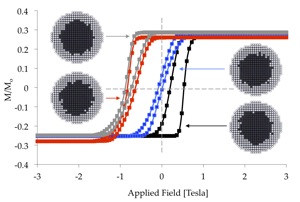Exchange Bias
Exchange bias is a magnetic phenomenon where a hysteresis loop, which relates the magnetic response of a material to an applied field, is shifted relative to the zero-field position. Exhange bias is commonly used in magnetic sensors, due to the enhanced thermal stability of the material. Exchange bias occurs when two magnetic materials are coupled together by the exchange interaction, which is also the fundamental interaction which leads to ferromagnetism. So the combination of the exchange interaction and a shift of the hysteresis loop is known as exchange bias.
Experimentally exchange bias is poorly understood, as the expected loop shifts are orders of magnitude too small. Core-shell ferromagnetic (FM) - anti-ferromagnetic (AFM) nanoparticles were the first system seen to exhibit exchange bias, yet their complexity means that the origin of exchange bias in these systems is still poorly understood.

Fig. 1: Atomistic Simulation of the heating and cooling process for an exchange biased core-shell nanoparticle.
We have investigated two important effects in core-shell FM-AFM nanoparticle systems. Initially we calculated the stabilising effects of the anti-ferromagnet (AFM) in core-shell nanoparticles [1]. Our results have demonstrated an increase in the energy barrier along the bias direction, with a corresponding decrease of the barrier in the opposite direction. This is a problem if such systems are to be used as magnetic storage devices, since essentially the magnetisation is only stable along one direction, so essentially one cannot write information by changing the direction of the FM core. In order to permit magnetic recording, which essentially requires a bi-stable system, we proposed a heat-assisted recording method, whereby both the ferromagnet (FM) and anti-ferromagnet (AF) are switched. Upon heating to the Néel temperature of the AFM, the magnetic order is destroyed allowing switching of the FM core with a small applied field. Thermal stability of the core is then restored after cooling back to room temperature. A visualisation of the particle and the variation of the magnetisation is shown in Fig. 1.

Fig. 2: Sample hysteresis loops for different exchange biased core-shell nanoparticles. The random interfacial roughness leads to very different magnetic behaviour.
Another effect we have investigated [2] is the influence of a rough interface between the core and shell. The interface properties are very important in these systems, since the exchange bias depends on the degree of compensation in the interface. Hysteresis loops for particles with different interfaces are shown in Fig. 2, demonstrating that different interfaces lead to huge changes in the bias field.
Additionally we found a strong correlation betweeen the degree of compensation in the interface, and the calculated exchange bias field. When looking at the collective hysteresis loops for a hundred particles, we found good agreement with the experimental hysteresis loops. However, this also suggests that experimental loops likely include a dispersion of properties.
Related Publications
| [1] | On beating the superparamagnetic limit with exchange bias. R. F. L. Evans, R. Yanes, O. Mryasov, R. W. Chantrell and O. Chubykalo-Fesenko Euro Physics Letters 88, 57004 (2009) [PDF] |
| [2] | Influence of interfacial roughness on exchange bias in core-shell nanoparticles. R. F. L. Evans, D. Bate, R. Yanes, R. W. Chantrell and O. Chubykalo-Fesenko Phys. Rev. B 84, 092404 (2011) [PDF] |




